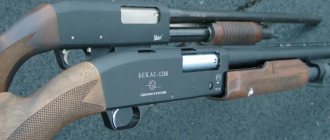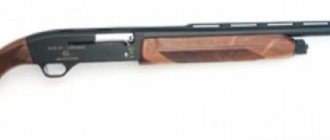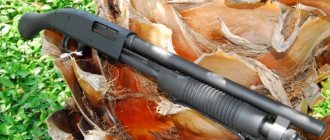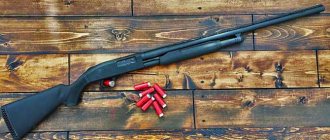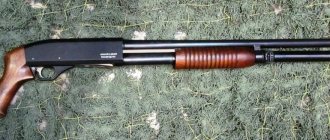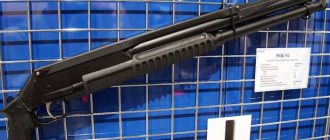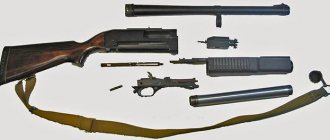Most hunting fans who own weapons with break-barrels and flip-up barrels dream of replacing it or purchasing it as a second one. The choice of samples is huge, since the arms market today represents almost all well-known companies. They produce weapons that are excellent in all respects, but many consumers are stopped by a significant drawback - cost. In addition, some samples show capriciousness during operation due to transportation conditions, exposure to dust and moisture. Taking into account all the features, hunters continue to trust their gun manufacturer by purchasing semi-automatic weapons created in our country. One of the options is “Bekas”, a gun produced in the Kirov Territory.
History of creation
The Bekas 12 pump-action shotgun is manufactured at the Vyatko-Polyansky Machine-Building Plant. The first sample was released in 1997. The gun was chambered for a 16-gauge cartridge.
Two years later, the plant produces a new pump-action shotgun called Bekas 12, which is successfully gaining popularity.
Soon another sample appears, with the letter “M” added to its name. The production of such weapons is being established in the following modifications:
- Snipe 12 M – pump-action weapon, 12 gauge;
- pump-action version 16 M - gun with a charge of 16 x 70 mm;
- VPO 202 Bekas 12 M is a sample designed for firing Magnum 12 cartridges.
The full index of models is Bekas RP 16 (12 M), but they are often called Bekas 12 (16) M. Weapons in this series are distinguished by the manual type of reloading, performed by the movement of a sliding fore-end.
Design
The Bekas 12 is a 12 gauge smoothbore pump action shotgun. The barrel of the Bekas 12 shotgun is made by cold forging, blued, with a chrome-plated channel. The muzzle has an extension for the installation of replaceable nozzles - payload or "Paradox".
The under-barrel magazine is a tubular type, designed for six charges. The barrel box is made by casting, for which aluminum alloy was used. The store's bunker window is located on the bottom edge.
The Bekas smoothbore shotgun has a swing-type bolt cylinder. It locks the barrel channel by engaging the tail cutout of the breech. The firing pin is spring-loaded, the tip does not protrude beyond the shutter mirror.
Buttstocks change in many models
The Bekas 12 model is equipped with a trigger mechanism. It should be noted that the striker is not adjustable along the hook path or trigger force. The safety flag in Bekas 12 is located on the rear branch of the trigger guard and can be in one of two positions:
- shift to the left, at right angles to the barrel axis - off;
- when you shift to the right, you can fire.
When the safety is turned on, the bolt frame can only be opened half the length of the cartridge case; it is impossible to feed a cartridge and cock the firing pin.
On top of the trigger, on the right, there is a lever that cuts off the supply of cartridges. When pressed, the bolt frame can be retracted to the entire length of the cartridge to remove it from the barrel. In this case, the next ammunition is not supplied to the elevator, and the firing pin remains in the cocked position.
The stock of the Bekas 12 pump-action shotgun has a semi-pistol shape and is made from walnut wood. The Bekas 12 M stock is distinguished by a straight comb, strongly inclined downward in relation to the barrel. The shock-absorbing butt pad is not adjustable. The handle along its entire length is corrugated, improving the grip. Long walnut fore-end. If the barrel channel is locked, it reaches the front edge of the box.
The Bekas brand hunting rifle is equipped with external sighting devices in the form of a ventilated rib and a bronze front sight.
Snipe 12-M-Auto
Photo by Alexey Klishin
It so happens that I give preference to domestic weapons. It’s somehow a pity to buy a “foreign car” for fairly decent money and scramble it in the forest. Moreover, our native domestic weapons are not as scary and unreliable as they are painted to be. Quite the contrary...
At the very beginning of the 2000s, I purchased a semi-automatic shotgun originally from Vyatskiye Polyany - “Bekas 12M Auto” with a barrel 70 cm long. This is a classic semi-automatic, reloaded by removing powder gases from the barrel.
To be honest, at first I didn’t want to buy a self-loading gun, leaning towards the “double-barrel classic”, but progress is progress... But I myself once criticized machine gunners while hunting. But any critic ends his criticism when he becomes more familiar with the subject and understands the operational conveniences that it carries within itself.
I was immediately impressed by the ergonomics, excellent balance and handling of the new gun. I didn’t have to get used to it: as they say, I started hitting shots with it from the first shot. The accuracy, sharpness, accuracy and uniformity of the scree were excellent.
The barrel is perfectly straight and light. The presence of removable choke constrictions (choke, choke and cylinder) allowed the gun to be universal for different hunts. By combining choke and half-choke constrictions with a selected cartridge, I always had a guaranteed high-quality result, no matter who I had to hunt. And in bullet shooting everything was excellent: at 100 m it was consistently possible to fit 5 bullets into a sheet of A4 paper.
I also really liked the fact that the gun turned out to be insensitive to contamination with needles and other “forest dirt.” But contamination with something like sand made this weapon inoperable.
I don’t see any point in changing this semi-automatic for something else. But besides such obvious boasting about the gun, I want to talk about a number of quite significant, in my opinion, shortcomings. Let's start with its coating: the gun is simply painted. This paint sticks well on the barrel but comes off the alloy box beautifully.
The gas outlet unit is of a rather complex design - it is unreasonable to disassemble it and clean it in the field. This requires a special tool, and there is always the possibility of losing something from its small structural elements. Particularly inconvenient is removing and putting back the lock washer of this unit.
To manipulate the gas outlet, you need a large, clean barrel and instructions at hand. If, nevertheless, someone tries to do this in the rain in a forest or field, then the gun will turn into a useless club, and the hunt will end at this stage.
Despite its shortcomings, the gas exhaust mechanism also has a huge advantage - it allows the use of any type of cartridges. Even with “light sporting” the automatic reloads the gun perfectly. Moreover, I have never heard any complaints about the automatic equipment of the Bekas 12M Auto.
It is not entirely clear why the gun magazine is designed with a “blind” front end. Because of this, it cannot be extended, and some difficulties may arise when cleaning the magazine. The magazine cutter is clearly unfinished. I had to read that some hunters turn it over during operation to the middle position, which leads to spontaneous ejection of the cartridge under the bolt and, as a result, to complete jamming of the weapon.
They also described a case where, in the forward switch position, a cartridge was still fed from the magazine to the cutoff. Loading a magazine by pressing a button is inconvenient, but you can easily get used to it. If for some reason you have to remove the magazine, then inserting the spring that has fallen out of it will be problematic. To install it backwards, it is better to find an assistant; it is extremely difficult to do this alone.
The trigger mechanism of the Bekas 12M Auto is very complex; it is better not to interfere with its structure unless absolutely necessary. At least I didn’t have such a need.
What else I didn’t like about the overall design of a very good gun was the not entirely logical attachment of the butt. When removing it, for example to replace it with another one, the screw is unscrewed and the fastening “nut” falls inside the box. As a result, we have a complete disassembly of the gun. Why does this happen? But because in the Bekas 12M Auto there is no thread for attaching the buttstock to the receiver.
The buttstock is attached through a hole in the receiver to a special shaped “nut” plate with a thread, which fits into special grooves inside the box. Screwing the stock without pressing the “nut” plate with your finger during complete disassembly can be compared to screwing a screw from below through a hole with an unsecured nut.
In addition, the “nut” may not be in its place when the butt appears to be securely fastened. When shooting and automatic operation begin, the “nut” will fall into place and give about 3 mm of axial movement of the butt. I had this happen, and therefore I prefer to disassemble the gun and, putting the plate in place, securely fasten the butt.
I can recall several cases when my “Snipe” did not reload while hunting. One day in 2006, the shutter jammed in the rear position. The reason was the tearing off of the bottom of the paper cartridge of the self-rolling cartridge. The cartridge case itself was half stuck in the chamber, and its metal bottom, captured by the bolt, became warped and jammed the bolt.
I resolved this misunderstanding very quickly. Another incident was when trying to “carefully” unload a gun after a hunt so that unfired cartridges did not fall into the dirt. He rested the butt on his side, placed his left palm under the receiver window and began to slowly open the bolt, expecting the cartridge to fall into his palm.
During this process, the right hand apparently jerked back and forth, and the feeder lifted the cartridge from the magazine while the cartridge was still in the receiver. The gun accordingly jammed. I can’t remember any other serious incidents with my gun.
What has happened to my Bekas after almost 10 years of operation? About a hundred ducks, a dozen hares and two wild boars. Is it a lot or a little? It seems to me that this is quite enough. And in all the previous hunts, this gun has never let me down, even if we count the incident with the torn off base of the cartridge case. An excellent hare was taken from this cartridge at 35–40 m; the Bekas malfunctioned only after its job was done.
We can touch on another rather important question: is a semi-automatic machine necessary for hunting? Many “proper hunters” consider using it bad manners. The answer is clear: a semi-automatic is much more convenient than a double-barreled shotgun, its recoil is noticeably less, and therefore the shot itself is more comfortable. Convenience when hunting is an important thing.
Is a large number of cartridges in the magazine necessary? Sometimes one shot is enough for an experienced hunter, but a magazine with a supply of cartridges will not hurt a beginner. Skill and experience never come instantly.
Passport for hunting rifle BEKAS-16-AUTO (16 caliber)
PURPOSE OF THE GUN 16th self-loading hunting shotgun. caliber model "Bekas-16 auto" is intended for various types of hunting in conditions from minus 30°С to plus 50°С
SPECIFICATIONS
Caliber 16 Barrel bore diameter, mm 17.0 Chamber length, mm 70 Barrel length, mm 680 Magazine capacity, cartridges 4 Gun weight (without accessories, case with belt), kg, no more than 3.6 Overall dimensions, mm, no more : length 1110 width 60 height 200 Accuracy of fire, %, not less at a distance of 35 m, for choke constrictions: PC 16.00.12-02 (choke) - 1.00 60 PC 16.00.12-01 (pay) 0.50 50 PC 16.00.12 (cylinder) -0.00 35
COMPLETENESS Table 1
| p/p | Designation | Name | Number | Note |
| 1 | PC.16.00.00 Sat | Self-loading hunting shotgun of 16 caliber "Bekas-16 auto" | 1 | |
| 2 | PC-16.00.12 | Replaceable bushing (cylinder) | 1 | |
| 3 | RS.16.00 12-01 | Replaceable bushing (pay) | 1 | |
| 4 | PC-16.0012-02 | Replaceable bushing (choke) | 1 | |
| 5 | RP-16.00.23 | Key | ||
| 6 | PC-16.03.04 | Drummer | upon request | |
| 7 | SOK-95 3.14 | Striker spring | upon request | |
| 8 | RP-16.03.07 | Ejector | no order | |
| 9 | RP-16.03.08 | Stop (extractor spring) | on order on order | |
| 10 | RP-16.03.09 | Ejector spring | 1 | upon request |
| 11 | NO-001 | Hunting knife | 1 | upon request |
| 12 | Screwdriver with plastic handle 7.5 GOST 3-4723-80 | |||
| 13. | Cleaning rod 782 GOST B18645-82 | 1 | upon request | |
| 14. | Tip 16 GOST V18644-82 | 1 | upon request | |
| 15 | 6U5 | Oiler 11 GOST V38419-73 | 1 | upon request |
| 16 | Punch 2.5x40 GOST V 18655-82 | 1 | upon request | |
| 17 | RP-16 4-110 SB | Case | ||
| 18 | KYu-5,6.1 SB 3-7 | Belt | 1 | upon request |
| 19 | PC-16 PS | Self-loading hunting shotgun of 16 caliber "Bekas 16 auto". Passport | 1 | |
| 20 | RP-16 K-2 | Cardboard box | 1 | |
| 21 | PC-16.00.14 | External sealing ring | 1 |
DEVICE AND PRINCIPLE OF OPERATION The 16-caliber self-loading hunting shotgun “.Bekas-16 auto” consists of the following components
Self-loading hunting shotgun - 16 caliber, model "Bekas-16 auto" in disassembled form: 1 - bolt; 2-box: 3-reloading handle; 4-ejector; 5-flag of the cartridge cutter: 6-axis of the trigger mechanism; 7-fuse; 8 — trigger hook; 9-butt; 10-barrel with rib and front sight; 11-shutter shutter button; 12-tray cartridge lifting; 13-ring external obturation; 14-ring internal obturation; 15 - gas chamber; 16-piston with rods; 17-return spring; 18-cap; 19-handguard; 20-shock trigger mechanism; 21 — bolt frame; 22 — screw with a ring; 23-back of the butt; 24-liner. To increase the durability of the gun and corrosion resistance, the bore and chamber of the barrel, as well as the sealing rings and the gas chamber are chrome-plated. Automatic reloading of the gun is carried out using the energy of the powder gases removed from the barrel bore into the gas chamber and the energy of the return spring. The bolt is locked by turning the locking wedge, i.e. entry of the wedge into the groove of the barrel. The trigger mechanism is mounted on a separate base. Tubular under-barrel magazine 6.2. The principle of operation of the gun is as follows: - when you press the trigger, the trigger disengages from the sear and, under the action of the mainspring, rotates around its axis, striking the firing pin. A shot occurs; — powder gases enter the gas chamber through holes in the barrel and, through obturating rings, press on the piston with rods; — the movement from the piston is transmitted through the rods to the bolt frame and it begins to move to the rear position, while the return spring begins to compress; — the bolt frame uses its tooth to rotate the locking wedge around its axis. The barrel bore is unlocked; - the bolt, continuing to move with the bolt frame, removes the spent cartridge case from the barrel using an ejector; - with further movement, the bolt frame with its lower plane acts on the trigger and the tray lifting lever, turning them around their axes, while the trigger stands on the sear; - when the frame with the bolt reaches its rearmost position, the rear end of the reflector rests against the bottom of the box and pushes the spent cartridge case out of the box window, while the left rod with its protrusion acts on the left stop of the cartridge and releases the outermost cartridge located in the magazine; — the cartridge, under the action of the magazine spring, moves to the tray, while pressing the shutter stop and the associated right cartridge stop, which stops the feeding of the next cartridge from the magazine; — under the action of the return spring, the bolt frame with the bolt begins to move forward, while its protrusion presses the tray lifting lever. The tray rotates on an axis and lifts the cartridge to the dispensing line; - with further movement, the bolt sends the cartridge into the chamber, the frame with its protrusion turns the locking wedge, which enters the window of the barrel shank, and the barrel bore is locked; — the tray returns to its original position under the action of a spring; — the gun is ready for the next shot; — to fire one shot, without feeding the next cartridge from the magazine or to replace a cartridge in the chamber, the gun is equipped with a cartridge cutter located on the left side of the gun. When the cutter is turned counterclockwise by 180°, the supply of cartridges from the magazine changes. To resume the supply of cartridges, the cut-off device must be turned clockwise to its original position. INDICATION OF SAFETY MEASURES Before using a gun, it is necessary to study the safety rules set out in the hunting minimum. The gun should always be treated as if it were loaded and ready to fire. REMEMBER! A gun should never be pointed at a person or pet. The gun should be stored unloaded, with the trigger pulled. Store ammunition in a place inaccessible to unauthorized people. In addition to the above, it is necessary to observe the following safety rules: 1) do not lean on the gun; 2) always keep the gun with the safety switch on to avoid accidental discharge; 3) before loading the gun, be sure to inspect the barrel bore and chamber - there should be no foreign objects in them; 4) when firing bullets, in order to avoid swelling and rupture of the barrel, the diameter measured along the body of the bullet without taking into account the centering ribs should be less than the diameter of the muzzle narrowing. For round bullets, this rule can be easily checked by freely passing the bullet through the muzzle; 5) keep records of the number of shots fired. Strictly prohibited; — disassemble a loaded gun; - use loaded cartridges when checking the interaction of parts and mechanisms of the gun - use cartridges that develop pressure higher than the operating pressure, equal to 74 MPa (755 kgf/cm2); - subject the gun to modifications, leading to changes in the shape, size and interaction of parts and mechanisms of the gun; - use other gunpowder and gunpowder that has expired, is damp and shows signs of decomposition, as well as dried smokeless gunpowder and mixtures of staves of various brands; - compress a charge of smokeless powder; - use an additional igniter made of smoke powder when equipping. In case of problems with a loaded gun, before finding out their causes, you must turn the push-button fuse located in the safety bracket to the “safety” position. In this case, the red ring on the fuse is not visible. PREPARING THE GUN FOR WORK 8.1. When preparing a gun for work, it is necessary to wipe the barrel bore and chamber if there is lubricant and powder deposits there 8.2. In the assembled gun, check the interaction of the mechanisms. 8.3. Attention! The replacement bushing must be screwed in all the way; the bushing must not protrude beyond the end of the barrel. The barrel mounting cap must be screwed in all the way. The gun is ready for use.
OPERATING PROCEDURE 9.1. Turning the fuse on and off 9.1.1. Turn on the fuse - move the push-button fuse all the way to the “Safety” position (4) 9.1.2. Turn off the fuse - move the push-button fuse to the “Fire” position, the red ring on the fuse is visible. 9.2. Loading and firing procedure: - use the handle to move the bolt to the rearmost position, and the bolt will be locked by stopping the bolt (1); — insert the cartridge into the window of the box (2); - press the shutter stop button, while the shutter, under the action of the return spring, sends the cartridge into the chamber and locks the barrel bore (3); — turn the gun with the bottom up and, pressing the shutter stop button and the feed mechanism tray, insert the cartridges one by one into the magazine until each cartridge is fixed by the box stop (5); If it is necessary to replace the cartridge located in the chamber with a cartridge with a different shot or bullet, set the flag of the cartridge release mechanism to a position that excludes the supply of cartridges from the magazine (7). Use the handle to move the moving parts to the rearmost position, while the previous cartridge is extracted from the box window (8). Then feed the required cartridge into the box window and press the stop button, while the moving parts will move to the forward position. Rotate the cutter to its original position. Attention! Load the gun through the chamber only with the safety switch on.
To fire a shot, aim and pull the trigger (6). To fire the next shot, release the trigger and press it again. When the magazine runs out of cartridges, the moving parts will remain in the rear position. After making sure that there is no cartridge in the chamber, move the bolt to the forward position. To do this, press the shutter stop button located on the right side of the front of the box.
DISASSEMBLY AND ASSEMBLY OF THE GUN (Fig. 4) When starting to disassemble, replace the barrel or replacement bushings, you must first make sure that the gun is not loaded. Check that there are no cartridges in the magazine and chamber. 10.1. Incomplete disassembly of the gun. 10.1.1. Unscrew the nut (cap) of the magazine and remove the forend (1).
Rice. 3. Operating procedure.
Rice. 4. Disassembling and assembling the gun. 10.1.2. Pull the bolt behind the charging handle and remove the barrel with the gas chamber. 10.1.3. Remove sealing rings. 10.1.4. Using a drift, push out the axis of the trigger mechanism and separate it, turning it outward and simultaneously moving it forward, while pressing the shutter stop button (2) with the thumb of your left hand. 10.1.5. Move moving parts away from. using the piston back until it stops and remove the locking wedge using the axis of the trigger mechanism (3). 10.1.6. Smoothly move the piston forward and remove it from the magazine, remove the return spring (3) 10.1.7. Remove the bolt carrier (5). 10.1.8. Remove the bolt and charging handle (4). 10.1.9. If necessary, you can remove the gas cameo from the barrel (4). 10.1.10. To disassemble the magazine, use a screwdriver to push the insert into the magazine body and, turning them 180°, remove them from the body. Attention! It is necessary to beware of spontaneous ejection of the liner when the magazine spring acts on it. 10.2. The gun is assembled in the reverse order. 10.3. Replacing replacement bushings (6). Replacement of replaceable bushings is carried out using a special key included in the spare parts kit (7). When replacing replaceable bushings (chokes), they must be screwed in until they stop. In this case, protrusion of the replaceable sleeve beyond the end of the barrel is not allowed. MAINTENANCE The service life and trouble-free operation of the gun largely depend on skillful and careful handling. During storage, the gun mechanism should be lightly lubricated with a thin layer of gun lubricant. 11.1. Preparing for shooting. 11.1.1. To prepare the gun for shooting, remove grease from the outer surfaces of the gun and from the barrel bore. 11.1.2. The following rules must be observed: - in the absence of a cartridge in the chamber, do not allow the bolt to suddenly hit the breech end of the barrel while moving the bolt to the extreme forward position; - monitor the cleanliness and serviceability of all parts of the gun; - do not allow snow, earth, etc. to get into the trunk. During intense shooting, after every 30-40 shots, clean the gas chamber and sealing bushings from carbon deposits. Cleaning and fairy tale. Inspect, clean and lubricate the gun no later than six hours after shooting. If cleaning is impossible, it is necessary to lubricate the barrel bore with the chamber, the inner surface of the gas chamber and the rod with RZh oil and, at the first opportunity, but no later than one day, clean it. In the future, when stored without use - at least once every three months. In winter, cleaning should be done indoors with an air temperature of 20+5°C after the gun has warmed up to room temperature. To clean the barrel bore and chamber, use a bristle brush or clean wiping material (rags, tow) free of sand and solid particles; clean until the powder residue is completely removed. Cleaning is carried out in the following sequence: 1. Lubricate the bore and chamber with a brush, dipping it in RJ, VO or KRM oil. 2. Wipe the bore dry using a wiper with a wiping material tightly wrapped around it. 3. Repeat the process of lubrication and wiping 8-10 times until carbon deposits are completely removed (checked by inspecting the barrel bore). 4. After cleaning, lubricate the barrel bore and chamber with clean oil RZH, VO or KRM. Remove lead deposits from the bore, chamber, gas chamber, obturating rings, and magazine body using a brush made of thin steel or brass wire, generously lubricated with gun lubricant. For greater reliability of the mechanisms, use lubricants that are appropriate for the time of year and recommended for guns. Thickening of the lubricant in the grooves of the bolt, in the grooves of the box, in the ejector socket and on the mainspring is unacceptable. Wipe wooden parts with a dry cloth. Failure to follow the instructions for cleaning, lubricating and storing the gun leads to corrosion damage to metal parts, including chrome plated ones. Storage. To maintain operational condition, a cleaned and lubricated gun should be stored in a cleaned and lubricated gun should be stored in a dry room, without sudden temperature fluctuations in the ambient air of aggressive impurities. To avoid permanent deformation of the spring, the trigger must be released. * If the outer sealing ring breaks, replace it with a spare part.
Vladimir Petrov October 5, 2012 at 00:00
Advantages and disadvantages
The Bekas 12 M shotgun has the following advantages:
- It is known throughout the world for its reliability and reliability. In terms of this indicator, the Bekas M pump-action shotgun is somewhat inferior to double-barreled shotguns, but has an advantage in rate of fire. After a misfire, a shotgun called Bekas is quickly reloaded, which makes it especially popular among law enforcement officers;
- chrome plating of the barrel bore greatly facilitates its cleaning;
- the 12 M shotgun fires ammunition whose cartridge case length is 7.6 cm. If you use shorter charges, the accuracy and range of fire will deteriorate somewhat, but there is a strong confidence that the smooth-bore weapon will not fail during hunting;
- The length of the forend and the notches on its surface make the reloading process easier. The user with different anatomical capabilities does not feel discomfort;
- the 12-gauge Bekas shotgun has excellent ballistics not only when firing shotguns, but also when firing bullet charges;
- the operating principle of a special lever stops the bolt frame. At this moment, you can remove one cartridge without feeding the next charge into the channel barrel. This feature allows you to quickly load a pump-action shotgun with ammunition of a different caliber;
- The semi-pistol stock does not cause any complaints, and the twelve-gauge gun itself is quite light, excellent for long-term hunting.
The Bekas 12 shotgun has proven itself on the market
Unfortunately, the Bekas 12 gun has certain disadvantages:
- The sound of the reloading mechanism for hunting is considered quite loud and can be heard in the forest at a great distance. The most noise occurs when the bolt cylinder jams behind the cutout located in the barrel shank;
- If you fire with shot from 12-gauge cartridges, the damage radius will increase, but the user will feel quite strong recoil. This feature limits the circle of users who love hunting.
- Some hunters criticize the non-adjustability of the buttplate.
Reviews from experienced hunters
In terms of its external characteristics, the weapon looks good, and only the presence of some small flaws keeps owners from giving it a higher rating. The point is that sometimes the forend does not fit tightly, there is a slight play, so I would like a better fit of the butt to the receiver. The barrel is well blued, there are no complaints here, but the owners of the weapon think that it would be great if the receiver had the same. Almost everyone likes the stock, although the weight distribution is satisfactory.
At first, you will have to get used to the weapon, especially if you previously owned a completely different type of weapon. But the process of getting used to it goes very quickly. A little longer the long barrel will be a little distracting, but you can get used to it.
Specifications
The main indicators of a pump-action shotgun are:
- type of design – smoothbore;
- caliber, mm – 12;
- A snipe with a trunk 75 cm long weighs no more than 3.6 kg;
- chamber, cm – 7;
- number of charges in the magazine, pcs - three, the fourth - in the barrel;
- the strength indicator at a permissible gas pressure of 70 MPa is 10,000 shots;
- types of charges used - bullet, shot, buckshot;
- The gun is distinguished by the peculiarity of the barrel with interchangeable attachments - a cylinder, a choke and a choke.
Bekas 12 is a good gun for its price
Disassembly and assembly
The algorithm for disassembling and assembling the Bekas 12 pump-action weapon is as follows:
- First of all, all charges are removed from the pump-action shotgun. To do this, you need to press the lever located above the trigger, then pull the forend back and remove the ammunition from the chamber;
- Having taken out the cartridge, you need to move the elevator inside the barrel box of the Bekas 12 product, for which the forend is retracted as far back as possible. Now all charges can be removed from the magazine;
- Having finished discharging Bekas 12, we perform a control release of the trigger mechanism. The pump-action shotgun should be pointed upward;
- Now we remove the barrel coupling, having first unscrewed the shaped fastening nut on it;
- We move the forend of the Bekas 12 pump-action product back to separate the cylinder and the breech. Now you can disconnect the receiver;
- remove the trigger from the box, and the traction lock from the bolt frame;
- after that we take out the bolt frame;
- The final stage of disassembly is removing the forend and removing the bolt.
Collecting the Bekas 12 pump sample is carried out strictly in the reverse order. If you make a mistake, you won't be able to assemble the weapon.
Shotgun Bekas 12m with pistol grip
How does a shotgun work?
At the bottom of the receiver there is a hopper window through which loading is carried out. When the forend moves rearward, the bolt frame begins to shift under the influence of its thrust, causing the cylinder to lower and disengage with the breech shank. As a result, the spent cartridge case will be extracted and the firing pin will be cocked. When the bolt frame approaches the butt plate in the receiver, the cartridge case will be ejected through the deflector lever. The magazine will open and a cartridge will be fed into the tray using a special tooth equipped with the left handguard rod. When the elevator rises and begins to move back, ammunition will be supplied. The larva will pick it up and send it to the chamber. In this case, the wedge-shaped tooth will fit into a special hole in the breech of the barrel.
Varieties
Among pump-action models, there are examples in which many parts can be changed. For example, in product 12 RP 12 M it is possible to change the stock and handle, and select one of the muzzle attachments. True, there are models that have retained their modularity, but are not distinguished by sufficient variability:
- The Bekas 16 is a traditional version of a pump-action shotgun, for reloading it is driven by the fore-end, which slides under the magazine along a separate tube. Its caliber is 16 mm, the magazine is spacious, holds six charges, the seventh cartridge is placed in the barrel. This specimen is available in several versions: barrel 71.7 cm + butt, analogue 57.2 cm long, pistol-shaped handle + barrel 57.2 cm. There are versions for hunting in which both versions of the butt and the barrel part are included in the kit and can be easily changed at any time;
- Bekas M is a continuation of the previous sample, which has the ability to use charges of both 12 and 16 gauges. The operating principle of the pump-action Bekas M has remained almost unchanged, but the design of the pump-action weapon has changed slightly, which had a positive impact on the accuracy of fire and its range. It is possible to install a stock or a pistol grip; the magazine holds four charges of two calibers - 12 x 70 or 16 x 70 mm. The drummer is reliably spring-loaded, the fuse is activated using a mechanical button;
- 12 M auto - from the name itself it becomes clear that this is a modified version of the previous pump-action model. The only peculiarity is recharging, which is completely automatic using the energy generated by the gases. Recently, the plant created another version of the model, firing 12 x 76 mm cartridges;
- 201 05 (VPO 201 05) - pump-action model with semi-automatic reloading. The delivery set includes a pair of 53.5 and 75 cm barrels. The first has a rear sight and front sight, and the longer one has a ventilated rib. Intended for Magnum ammunition caliber 12 x 76 mm;
- 201 M (VPO 210 M) - another semi-automatic pump-action version with a modified reloading mechanism, which has become simpler, more stable and easier to use. The design and functionality have not changed much from the previous model, but the appearance has become more attractive: walnut wood began to be used to make the butt, its shapes became interesting and ergonomic. The barrel box has a Weaver mount for mounting various sights;
- VPO 202 04 and VPO 202 07 - both have a barrel length of 53.5 cm, only the weapon model VPO 202 07 can be produced at 75 cm. The VPO 202 04 product has a semi-pistol grip and a walnut stock, the kit includes a pistol grip and a pair of interchangeable nozzles of length 15 cm. For the professional version of VPO 202 07, a similar set of barrel narrowings is provided.
Snipe is popular among hunters
Convenient improvements
- Weight reduction due to the manufacture of the receiver from a durable and very high-quality aluminum alloy.
- The fore-end, handle and butt are made of Turkish walnut. This durable and reliable natural material is often used in weapons production.
- To reduce recoil, the stock was improved by adding a special rubber insert.
- There are four standard grooves on the receiver. They are located two on both sides and serve to attach the bracket for the optics.
Gun care
A few words need to be said about how to care for Bekas 12. We should start with the fact that Bekas 12 pump-action shotguns are unpretentious and do not require special attention, but it is still recommended to carry out basic procedures constantly. They consist of periodically cleaning and lubricating the Bekas 12 pump-action weapon. For ease of disassembly, the kit includes a key and drifts, which is quite enough.
By properly caring for the Bekas 12 pump pump, you will reliably protect yourself from misfires and other problems. Complete disassembly and cleaning of Bekas 12 is performed once a year.
